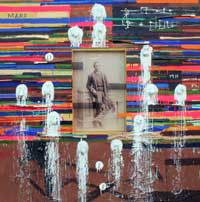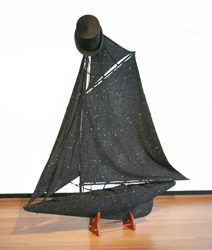Radcliffe Bailey: A New Generation
by Karla Klein Albertson, STYLE CENTURY MAGAZINE
RADCLIFFE BAILEY, born in 1968, belongs to the next generation of Southern artists. Yet, like many working today, he readily acknowledges John Scott’s influence and encouragement. Like Scott, Bailey’s work draws inspiration from music. He once said about his creative method, “I would draw comparisons to a jazz musician’s search for a certain sound, riff or rhythm, through acts of improvisation.”

Four and One Corner, South, 2005
Bailey has exhibited his work continually since his graduation from the Atlanta College of Art in 1991, and examples now hang in major American institutions from the Metropolitan Museum of Art to the San Francisco Museum of Art. Bailey is represented by several galleries including Solomon Projects in his home town of Atlanta and Jack Shainman in New York City. But a series of one-man shows at the Arthur Roger Gallery in New Orleans – the most recent in March 2008 – allowed him to become acquainted with John Scott and his circle of students there.
In an interview with Style Century Magazine, Bailey remembered how Scott and other New Orleans artists would come to view past shows: “When I was putting this show together for New Orleans, I had John Scott in my mind. I found something in common with him in the last few years because he seemed like a man of many materials. I found myself looking at my work in the same way. He had this same language – although visually the results can be very different. I felt myself moving in the same direction.”
“My sculpture professor was real good friends with John Scott. I’ve always been interested in making sculpture, and I’ve tried to make sculptural paintings. I’ve had a hard time trying to define myself in a way, because I’ve always questioned what we call painting and what we called sculpture. I felt I could make paintings with the paint thick enough that they become sculptural. My studio has always been like an installation of objects, and I incorporate those objects in my paintings.”
One of Radcliffe Bailey’s defining characteristics has been an interest in exploring his family history on these shores and across the ocean in Africa, a curiosity expressed in his recent mixed media sculptures of sailing ships. He explained, “The ships to me represent a lot of different things – slave ships – but a lot of the boats are more contemporary. They reference people making a spiritual migration back to places.” The artist mentioned that on his father’s side, there were family members that were Garveyites, referring to Marcus Garvey (1887-1940), a national hero of Jamaica who evolved a pan-African philosophy that found many adherents.

Tricky, 2008
He continued, “I wanted to trace my family because I wanted to figure out who I was artistically. Instead of just adopting the things I was picking up in school, I wanted to learn more. I went to visit my grandmother one Christmas before she died, and she said, I have something for you. She went into the back room and came out with a family album. There were about 400 photographs, most of them were tintypes. From then on, I’ve been using these old photographs. I was on a quest, regardless of what people thought.”
Bailey’s quest recently took him to Senegal. A 2008 work, Bay of Soumbedioune in Dakar, was one result of this journey. As is the case with Scott, few of Bailey’s works are sold on the secondary market. Family Collage, a mixed-media work on paper incorporating an ancestor image, did sell in January 2007 at the Auction Gallery of the Palm Beaches for $4,000.
A catalog essay by Terrie Sultan, director of the Blaffer Gallery at the University of Houston, offered this summation of his work: “Radcliffe Bailey seeks to understand the present by massaging the past experiences of his forebears. He does this through a performative and expressionistic iconography that is seductively beautiful in terms of form qualities of color and composition, and deeply engaging in content.”
